Subaru Legacy: Loading your vehicle
 Subaru Legacy: Loading your vehicle
Subaru Legacy: Loading your vehicle
WARNING
Never allow passengers to ride on a folded rear seatback, in the trunk or in the cargo area. Doing so may result in serious injury.
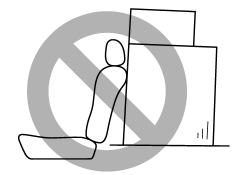
WARNING
● Never stack luggage or other cargo higher than the top of the seatback because
it could tumble forward and injure passengers in the event of a sudden stop or accident.
Keep luggage or cargo low, as close to the floor as possible.
● When you carry something inside the vehicle, secure it whenever you can to prevent
it from being thrown around inside the vehicle during sudden stops, sharp turns
or in an accident.
● Do not pile heavy loads on the roof. These loads raise the vehicle’s center of
gravity and make it more prone to tip over.
● Secure long items properly to prevent them from shooting forward and causing serious
injury during a sudden stop.
● Never exceed the maximum load limit. If you do, some parts on your vehicle can
break, or it can change the way your vehicle handles. This could result in loss
of control and cause personal injury. Also, overloading can shorten the life of
your vehicle.
● Do not place anything on the rear shelf behind the rear seatback (Legacy) or the
extended luggage cover (Outback). Such items could tumble forward in the event of
a sudden stop or a collision. This could cause serious injury.
CAUTION
Do not carry spray cans, containers with flammable or corrosive liquids or any other dangerous items inside the vehicle.
NOTE
For better fuel economy, do not carry unneeded cargo.
- Vehicle capacity weight
- GVWR and GAWR (Gross Vehicle Weight Rating and Gross Axle Weight Rating)
- Roof rails with integrated crossbars (Outback)
Vehicle capacity weight
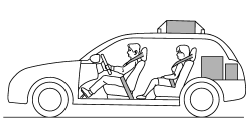
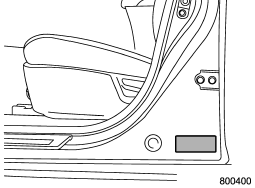
The load capacity of your vehicle is determined by weight, not by available cargo space. The maximum load you can carry in your vehicle is shown on the vehicle placard attached to the driver’s side door pillar. It includes the total weight of the driver and all passengers and their belongings, any optional equipment such as a trailer hitch, roof rack or bike carrier, etc., and the tongue load of a trailer.
GVWR and GAWR (Gross Vehicle Weight Rating and Gross Axle Weight Rating)
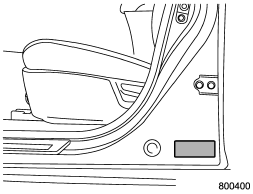
Certification label
The certification label attached to the driver’s side door shows GVWR (Gross Vehicle Weight Rating) and GAWR (Gross Axle Weight Rating).
The GVW (Gross Vehicle Weight) must never exceed the GVWR. GVW is the combined total of weight of the vehicle, fuel, driver, all passengers, luggage, any optional equipment and trailer tongue load. Therefore, the GVW changes depending on the situation.
In addition, the total weight applied to each axle (GAW) must never exceed the GAWR. The front and rear GAWs can be adjusted by relocating luggage inside the vehicle.
Even if the total weight of your luggage is lower than the vehicle capacity weight, either front or rear GAW may exceed the GAWR, depending on the distribution of the luggage.
When possible, the load should be evenly distributed throughout the vehicle. If you carry heavy loads in the vehicle, you should confirm that GVW and front and rear GAWs are within the GVWR and GAWR by putting your vehicle on a vehicle scale, found at a commercial weighing station.
Do not use replacement tires with a lower load range than the originals because they may lower the GVWR and GAWR limitations. Replacement tires with a higher load range than the originals do not increase the GVWR and GAWR limitations.
Roof rails with integrated crossbars (Outback)
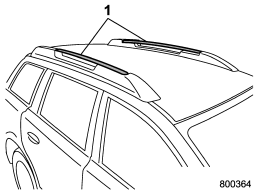
1) Integrated crossbars
CAUTION
● For cargo carrying purposes, the bars must be used as crossbars and be used together with the genuine SUBARU carrying attachment. The bars must never be used alone to carry cargo. Otherwise, damage to the roof or paint or a dangerous road hazard due to loss of cargo could result.
● When using the bars as crossbars, make sure that the total weight of the carrying attachment and cargo does not exceed the maximum load limit. Overloading may cause damage to the vehicle and create a safety hazard.
The bars can be used as crossbars. Cargo can be carried after setting the bars as crossbars and installing the genuine SUBARU carrying attachment.
When you carry cargo on the roof using the crossbars and a carrying attachment, never exceed the maximum load limit explained in the following. You should also be careful that your vehicle does not exceed the Gross Vehicle Weight Rating (GVWR) and front and rear Gross Axle Weight Rating (GAWR). For information on loading cargo into or onto your vehicle, refer to “Loading your vehicle” F8-12. The maximum load limit of the cargo and carrying attachment must not exceed the allowable load limit described in the Owner’s Manual of a genuine SUBARU carrying attachment. Place the heaviest load at the bottom, nearest the roof, and evenly distribute the cargo. Always properly secure all cargo.
Installing carrying attachments on the crossbars
When installing any carrying attachment such as a bike carrier, ski carrier, kayak carrier, cargo basket, etc. on the crossbars, follow the manufacturer’s instructions and make sure that the attachment is securely fixed to the crossbars. Use only genuine SUBARU attachments. A set of the crossbars is designed to carry loads (cargo and attachment) of not more than the allowable load limit described in the Owner’s Manual of a genuine SUBARU carrying attachment. Before operating the vehicle, make sure that the cargo is properly secured on the attachment.
NOTE
● Remember that the vehicle’s center of gravity is altered with the weight of the load on the roof, thus affecting the driving characteristics. Drive carefully, avoid rapid starts, hard cornering and abrupt stops. Crosswind effects will be increased.
● Restore the bars to the original position when the bars are not used as crossbars.
How to use as crossbars
CAUTION
● Do not raise the bar higher than necessary. The base of the bar may be damaged.
● Be careful not to contact the bars while sliding them. Otherwise, the bars may
be scratched or the latch portions may be damaged.
● Do not slide the bar more than necessary when sliding the bar. The base of the
bar may be damaged.
● Do not allow the bar to fall on or contact the roof panel or the moonroof when
sliding the bar. Otherwise the roof panel may be dented or the glass of the moonroof
may be damaged.
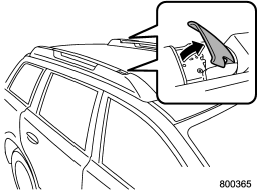
1. Pull out the integrated crossbars from the roof rail holders by pulling up the covers.
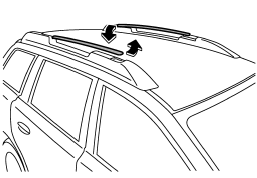
2. Slide the bars in the direction shown in the illustration.
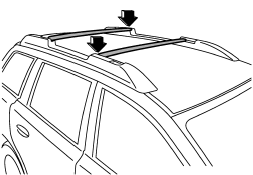
3. Install the bars into the holders.
4. Make sure that the latches are fitted securely.
How to re-stow bars
CAUTION
Do not use the bars as roof rails when the bars are stowed.
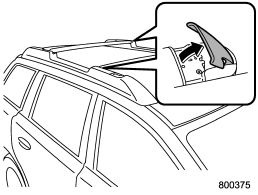
1. Pull out the crossbars from the roof rail holders by pulling up the covers.
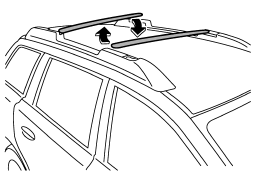
2. Slide the bars in the direction shown in the illustration.
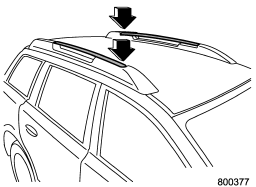
3. Install the bars into the holders.
4. Make sure that the latches are fitted securely.


